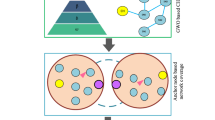Abstract
In energy-constrained wireless sensor networks (WSNs), geographic routing (GR) also known as location-aware routing has been developed because it uses neighbourhood locality data as an alternative of overall topology information for routing. But, this protocol frequently suffers from the energy holes in the data transmission resulting in path failure. To avoid this problem, energy-aware dual-path GR (EDGR) protocol has been suggested to improve the routing path from energy holes. However, it is unable to heal the energy holes since the node mobility can generate new energy holes. Also, higher mobility distance can cause high energy consumption (EC) and node failure. Hence in this article, an energy-efficient distributed collaboration mechanism is proposed with EDGR for \(k\)-coverage energy holes detection and healing in WSN that minimizes the delivery delay (DD). In this protocol, the distributed Voronoi-based collaboration (DVOC) method is applied in which the nodes can cooperate in energy holes detection and recovery. The nodes are enabled to monitor each other node’s critical locations around themselves by constructing the local Voronoi diagrams (LVDs). Moreover, an optimized DVOC (ODVOC) is proposed with EDGR in which intelligent water drop (IWD) algorithm is used to find the globally optimized routes to minimize the DD. Finally, the simulation outcomes demonstrate the ODVOC-EDGR accomplishes higher effectiveness than the EDGR and DVOC-EDGR in terms of different performance metrics.












Similar content being viewed by others
References
Soni, V., Mallick, D.K.: Location-based routing protocols in wireless sensor networks: a survey. Int. J. Internet Protoc. Technol. 8(4), 200–213 (2014)
Cadger, F., Curran, K., Santos, J., Moffett, S.: A survey of geographical routing in wireless ad-hoc networks. IEEE Commun. Surv. Tutor. 15(2), 621–653 (2013)
Kumar, A., Shwe, H.Y., Wong, K.J., Chong, P.H.: Location-based routing protocols for wireless sensor networks: a survey. Wirel. Sens. Netw. 9(1), 25–72 (2017)
Huang, H., Yin, H., Min, G., Zhang, J., Wu, Y., Zhang, X.: Energy-aware dual-path geographic routing to bypass routing holes in wireless sensor networks. IEEE Trans. Mob. Comput. 17(6), 1339–1352 (2017)
Chen, Q., Kanhere, S.S., Hassan, M.: Adaptive position update for geographic routing in mobile ad hoc networks. IEEE Trans. Mob. Comput. 12(3), 489–501 (2013)
BalaAnand, M., Karthikeyan, N., Karthick, S.: Designing a framework for communal software: based on the assessment using relation modelling. Int. J. Parallel Prog. (2018). https://doi.org/10.1007/s10766-018-0598-2
Cheng, L., Niu, J., Cao, J., Das, S.K., Gu, Y.: QoS aware geographic opportunistic routing in wireless sensor networks. IEEE Trans. Parallel Distrib. Syst. 25(7), 1864–1875 (2013)
Petrioli, C., Nati, M., Casari, P., Zorzi, M., Basagni, S.: ALBA-R: load-balancing geographic routing around connectivity holes in wireless sensor networks. IEEE Trans. Parallel Distrib. Syst. 25(3), 529–539 (2014)
Coutinho, R.W., Boukerche, A., Vieira, L.F., Loureiro, A.A.: Geographic and opportunistic routing for underwater sensor networks. IEEE Trans. Comput. 65(2), 548–561 (2015)
Niaz, F., Khalid, M., Ullah, Z., Aslam, N., Raza, M., Priyan, M.K.: A bonded channel in cognitive wireless body area network based on IEEE 802.15.6 and internet of things. Comput. Commun. 150, 131–143 (2020)
Hieu, T., Dung, L., Kim, B.S.: Stability-aware geographic routing in energy harvesting wireless sensor networks. Sensors 16(5), 696 (2016)
Ahilan, A., Manogaran, G., Raja, C., Kadry, S., Kumar, S.N., Kumar, C.A., Murugan, N.S.: Segmentation by fractional order darwinian particle swarm optimization based multilevel thresholding and improved lossless prediction based compression algorithm for medical images. IEEE Access 7, 89570–89580 (2019)
Huang, H., Zhang, J., Zhang, X., Yi, B., Fan, Q., Li, F.: EMGR: Energy-efficient multicast geographic routing in wireless sensor networks. Comput. Netw. 129, 51–63 (2017)
Julio, M.J.C., Enrique, M.-M.C., Daniel, B., Ruben, G.C.: Natural language interface model for the evaluation of ergonomic routines in occupational health (ILENA). J. Ambient Intell. Humaniz. Comput. 10(2019), 1611–1619 (2019)
Kumar, S., Kumar-Solanki, V., Choudhary, S.K., Selamat, A., Gonzalez-Crespo, R.: Comparative study on ant colony optimization (ACO) and K-means clustering approaches for jobs scheduling and energy optimization model in internet of things (IoT). Int. J. Interact. Multimed. Artif. Intell. (2020). https://doi.org/10.9781/ijimai.2020.01.003
Adnan, A.I., Hanapi, Z.M., Othman, M., Zukarnain, Z.A.: A secure region-based geographic routing protocol (SRBGR) for wireless sensor networks. PLoS ONE 12(1), e0170273 (2017)
Son, L.H., et al.: A new representation of intuitionistic fuzzy systems and their applications in critical decision making. IEEE Intell. Syst. 35(1), 6–17 (2020)
Wang, S., Fan, C., Hsu, C.-H., Sun, Q., Yang, F.: A vertical handoff method via self-selection decision tree for internet of vehicles. IEEE Syst. J. 10(3), 1183–1192 (2014)
Author information
Authors and Affiliations
Corresponding author
Additional information
Publisher's Note
Springer Nature remains neutral with regard to jurisdictional claims in published maps and institutional affiliations.
Rights and permissions
About this article
Cite this article
Sridhar, M., Pankajavalli, P.B. An optimization of distributed Voronoi-based collaboration for energy-efficient geographic routing in wireless sensor networks. Cluster Comput 23, 1741–1754 (2020). https://doi.org/10.1007/s10586-020-03122-1
Received:
Revised:
Accepted:
Published:
Issue Date:
DOI: https://doi.org/10.1007/s10586-020-03122-1




